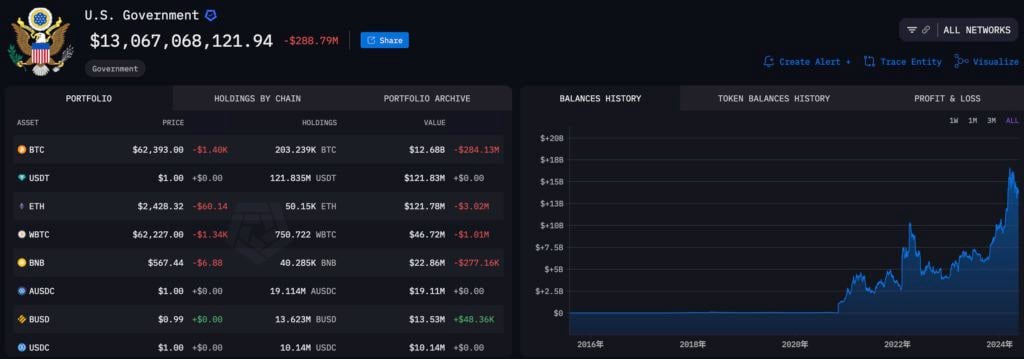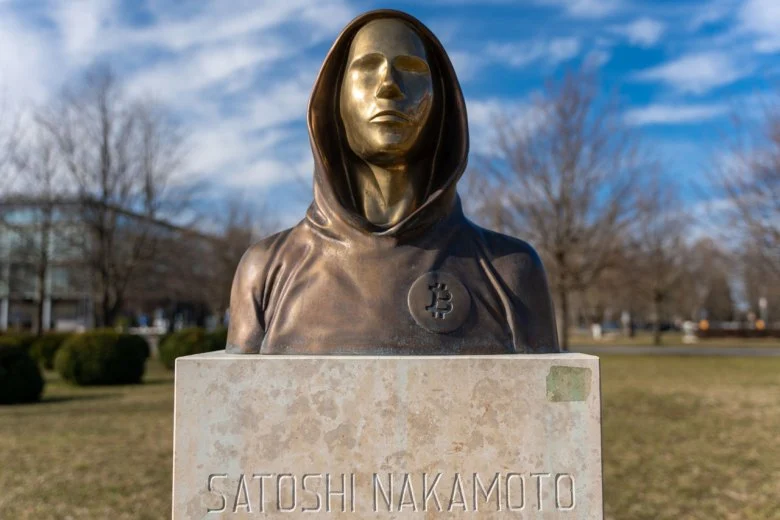Elon Musk’s net worth is projected to reach $1 trillion by 2035, exceeding the combined market capitalization of Ethereum, USDT, XRP, and BNB, prompting deep reflection on personal wealth and the concept of decentralization. This article is based on an article by Liam Akiba Wright, compiled, translated, and written by Foresight News
![图片[1]-Musk vs. Ethereum: Who will reach the $1 trillion goal first?-OzABC](https://www.ozabc.com/wp-content/uploads/cover-image-musk-vs-ethereum-trillion-dollar-race-768x512-1.webp)
whenWhen Elon Musk’s net worth surpassed the trillion-dollar mark, it was not only a sign of personal success, but also heralded a new stage in economic history—a stage in which individual influence could rival that of sovereign nations.
As a Bitcoin holder, I view Satoshi Nakamoto’s vision of “decentralized wealth” and “financial democratization” as a blueprint for decentralized power, an idea that reduces the dependence of the value system on a single entity. However, as capital, artificial intelligence, and policy increasingly converge on Musk’s ever-expanding business empire, his rise reveals just how far we have strayed from this ideal.
The ownership of “value” is once again becoming centralized, but this time, the controllers are not governments or banks, but individuals who turn technology into leverage.
Some argue that Bitcoin represents the purest form of private property: it is unconfiscable, borderless, and entirely controlled by individuals. From this perspective, Satoshi Nakamoto might not view the emergence of “millionaires” as a failure of decentralization, but rather as a logical (though unintended) outcome of its development.
Musk’s meticulously designed “wealth feast”
To date, Tesla shareholders have approved a compensation package that could increase Musk’s net worth to $1 trillion if all the milestones set in the package are achieved.
At Tesla’s annual shareholder meeting on November 6, over 75% of the votes supported the multi-year plan centered on stock options. The plan’s compensation is contingent upon Tesla meeting a series of operational and valuation hurdles, including achieving a market capitalization of nearly $8.5 trillion and large-scale deployment of self-driving technology and humanoid robots.
The numerical logic behind Tesla’s plan presents an unusual contrast: the equity exposure of a single entity could potentially exceed the combined market capitalization of the four major altcoins (ETH, USDT, XRP, and BNB).
How to cross the finish line: A game of wealth, power, and policy.
If all of Musk’s stock options were subject to concurrent options, his actual shareholding would likely reach around 25%, without considering equity dilution and financing effects.
Based on Tesla’s market capitalization of $8.5 trillion, a 27% stake in the company would be worth approximately $2.295 trillion. As of mid-2025, SpaceX (the US private aerospace manufacturer and space transportation company founded by Elon Musk in 2002) was valued at nearly $350 billion in the private market, and optimistic public forecasts indicate that its valuation in the defense and broadband sectors will exceed $1 trillion by 2030.
Rumors surrounding xAI (the artificial intelligence company founded by Musk in 2023) have raised valuations ranging from $75 billion to $200 billion. In summary, the “convexity of returns” in this option plan deeply binds Musk’s personal wealth to a few “either/or” outcomes, the most crucial of which are the commercialization progress of robotaxis and humanoid robots.
Achieving these goals is not only limited by technology but also constrained by policy. In California, for example, Tesla currently only holds a “permit for testing with a safety driver” from the California Department of Motor Vehicles (DMV) and has not yet obtained a “permit for testing and deploying driverless vehicles” to commence commercial operations. According to California government records and Reuters, each stage of the ride-hailing service’s development also requires separate approval from the California Public Utilities Commission (CPUC).
As previously reported by the technology media Ars Technica, the National Highway Traffic Safety Administration’s (NHTSA) review of “fully automated driving (FSD) functions” remains a potential risk that could attract public attention.
A rational view of the “trillion-dollar challenge” of cryptocurrencies
Currently, Musk’s net worth exceeds the market capitalization of any single altcoin. In the cryptocurrency space, only Bitcoin’s market capitalization (over $2 trillion) surpasses his personal wealth—and I am extremely optimistic about Bitcoin, believing it will continue to outperform any individual’s portfolio.
Ethereum, the second-largest cryptocurrency by market capitalization, has seen its market value fluctuate between $390 billion and $600 billion in recent months, currently around $400 billion, about $100 billion less than Musk’s personal wealth.
Next, let’s conduct some basic forward-looking modeling analysis:
Conservative scenario:
If the rollout of autonomous driving technology is delayed and the Optimus humanoid robot remains confined to niche applications, Tesla’s valuation could reach $3 trillion by 2035. At that point, Musk’s 25% stake in Tesla would generate approximately $750 billion in revenue. Adding SpaceX’s $500 billion valuation and xAI’s $50-100 billion valuation, his total assets would be around $1.3-1.35 trillion. After deducting option exercise costs, taxes, and loans, his net worth would be slightly less than $1 trillion, and he might not even be able to surpass that threshold.
In comparison, if Ethereum’s price reaches $5,000 and its circulating supply is 125 million, its market capitalization would only be approximately $625 billion.
Baseline scenario:
If Tesla’s market capitalization reaches $5 trillion, Optimus Prime is put into operation in the factory first, and the energy business achieves large-scale expansion, Musk’s Tesla shares will be worth $1.25-1.45 trillion. Combined with SpaceX’s $1 trillion valuation and xAI’s $200 billion valuation, his net worth exceeding $1 trillion will become a “basic outcome.”
Even with a price close to $10,000 and a circulating supply of 120-125 million Ethereum, its total market capitalization is only around $1.2-1.25 trillion.
Optimistic scenario:
If Tesla’s market capitalization reaches $8.5 trillion, self-driving taxis are widely used, and humanoid robots achieve mass production; at the same time, SpaceX’s valuation moves toward $2.5 trillion, and xAI’s valuation exceeds $500 billion, Musk’s personal wealth will reach the “trillion-dollar” level.
This comparison is not a contest between “individual heroes” and “technical agreements,” but rather a competition between “equity option returns” and “network adoption rates.”
![图片[2]-Musk vs. Ethereum: Who will reach the $1 trillion goal first?-OzABC](https://www.ozabc.com/wp-content/uploads/musk-vs-ethereum-who-will-reach-the-1-trillion-goal-first.png)
Therefore, if Ethereum is to surpass Musk (and his assets) and be the first to break through the $1 trillion valuation within the next decade, its price needs to exceed $10,000, assuming Tesla’s market capitalization does not exceed $3 trillion.
The influence and wealth politics of billionaires
However, I believe the “social narrative framework” surrounding these numbers is equally important.
Research published by Cambridge University Press shows that the worship of the super-rich, and the accompanying notions of “elitism” or “institutional justification,” reduces support for wealth redistribution and progressive taxation—an effect that also exists among low-income groups.
Long-standing research in political science has shown that policy outcomes respond far more to the preferences of the wealthy than to those of ordinary citizens. This implies that extreme concentration of wealth can translate into lasting political influence.
Meanwhile, economic research (such as the Quarterly Journal of Economics and related literature) has found that contact with wealthier groups reduces an individual’s life satisfaction while increasing conspicuous consumption and borrowing behavior—an effect that is particularly pronounced among the lower income groups.
A 2024 Harris Poll showed that a majority of respondents believed that “billionaires do not contribute enough to society”; and related surveys in the UK also indicated that the public is generally concerned about “the excessive political influence of the super-rich”.
These are not abstract opinions surrounding celebrities, but rather concrete channels through which the “halo effect” of billionaires and media narratives influence fiscal budgets, election voting, and social debt.
Defining ethical boundaries from a scale perspective
According to Forbes magazine, the number of billionaires worldwide will reach a record high of 3,028 in 2025. With a global population of approximately 8.23 billion, this means that only about one in every 2.7 million people will be a billionaire.
There are currently no billionaires (thousands of dollars) in the world. According to UBS estimates, global household wealth totals $450 trillion, with $1 trillion representing only 0.22% of that. Reuters’ interpretation of UBS data shows that the median wealth of adults globally is only “several thousand dollars,” with over 80% of adults having less than $100,000 in wealth.
One trillion US dollars in personal wealth is roughly equivalent to the combined net worth of 100 million to 130 million “middle-income adults.” The probability of going from a millionaire to a billionaire is already extremely low, so viewing “trillion dollars” as a goal that the public can pursue is clearly illogical from a numerical perspective.
Policy choices are a key variable affecting the “top wealth group.” Current rules allow the wealth of the top to continue to grow at compound interest, but combined with the “policy bias towards the wealthy” mentioned earlier, “affordability issues” in the livelihood sector (such as housing and medical costs) are often addressed with delay.
As demonstrated by economist Zucman’s simulations, cited by Oxfam, and reported by The Washington Post, a targeted annual tax of 2% on the wealth of billionaires could raise approximately $250 billion annually. This funding could be used to finance public goods or alleviate cost-of-living pressures, while moderately narrowing the gap between the wealthiest and ordinary people.
In experimental scenarios, if social culture shifts from “narratives of individual heroism” to “systematic interpretations of progress,” public support for progressive taxation will increase significantly—this will provide a more moderate check on the spillover effects of “worship of the wealthy.”
Policy and public perception shape the trillion-dollar race
These measures themselves will not change Tesla’s valuation logic or the demand curve for cryptocurrencies, but they can adjust the “external environment” in which huge wealth exists.
Tesla’s internal governance issues are also noteworthy: not only the board of directors, but also shareholders have valued and approved the “convexity of returns” of stock options—a process that addresses certain criticisms but has also sparked new controversies.
If state regulators and safety agencies can effectively manage the “cash flow from autonomous driving that underpins the payroll program,” then the current public regulatory system will act as an “upstream gatekeeper” in a “trillion-dollar private wealth option.”
According to Reuters and records from the California Department of Motor Vehicles, Tesla still needs to obtain “driverless testing and deployment permits” to achieve large-scale operation of its self-driving taxis in key markets; meanwhile, the NHTSA’s review is ongoing. The timeline of these approvals, not a press conference, will determine whether the pay plan can be implemented.
We don’t need to cheer or mock Musk to clearly see this comparison:
For cryptocurrencies to reach a scale of $1-2 trillion, they rely on “adoption rate, throughput, and capital flow”; while for founders to accumulate wealth of more than $1 trillion, they rely on “a few technological breakthroughs and regulatory approval”.
People can admire Musk’s execution or technological innovation, but there’s no need to promote a “culture of ostentatious wealth worship”—a culture that weakens support for wealth redistribution while amplifying the influence of the elite on policy. The logic is obvious: whether or not to worship him is a personal choice.
Ultimately, regardless of whether the first entity to break the $1 trillion mark is an individual or the internet, the more important question is: what kind of system do we want to empower? A system built on individual ambition, or a system based on collective identity and participation?

















